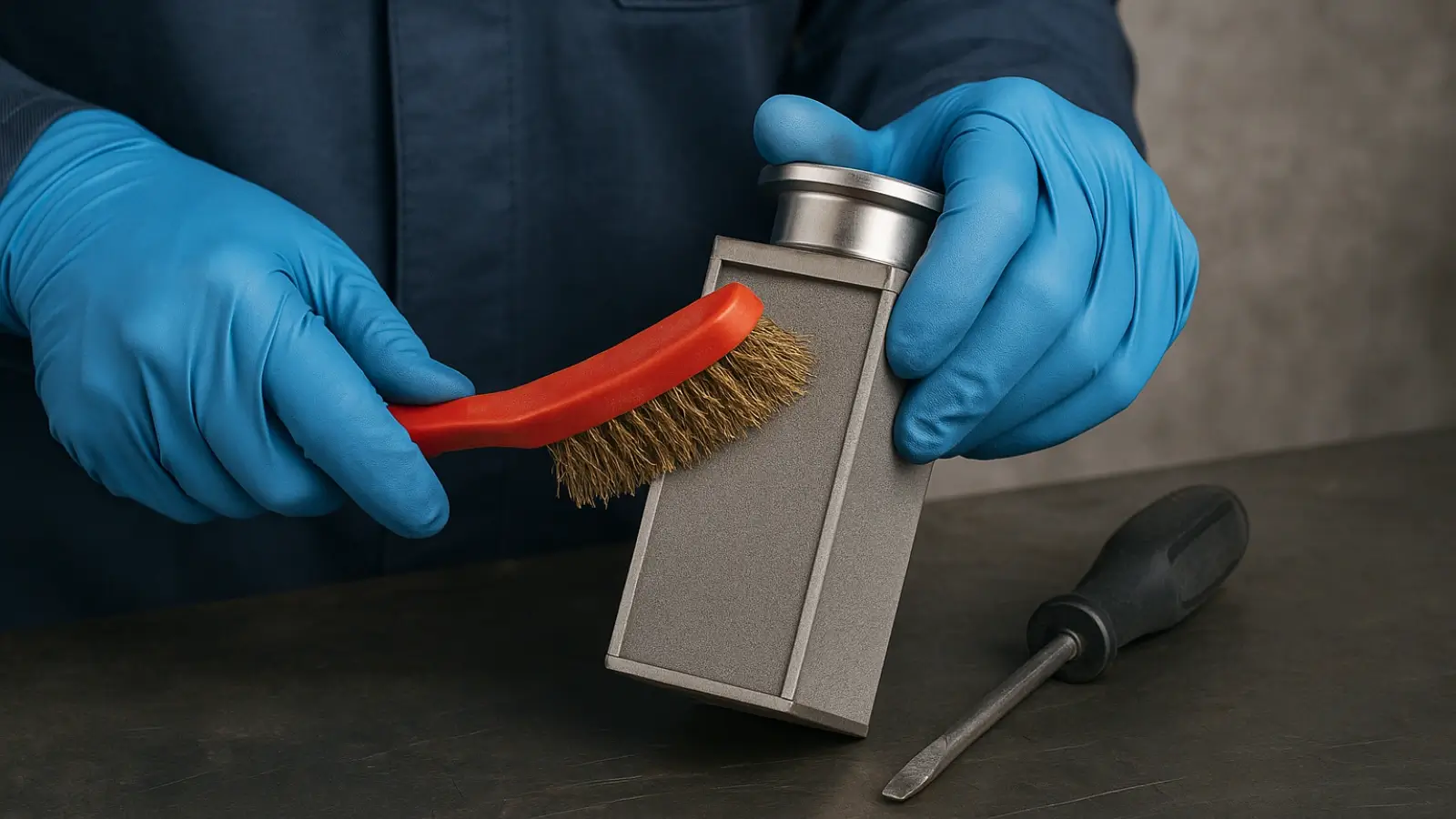


Sintered stainless steel filters are tough tools used in many industries. They help clean gases and liquids by trapping dirt and particles. These filters are made by pressing stainless steel powder into shape and heating it to bond the particles without melting them. This creates a strong, porous structure that lasts long. But like any tool, they need care to work well over time.
If you use these filters in your setup, knowing how to maintain them can save money and time. Poor care leads to clogs, lower flow, and early replacement. This guide covers everything from basics to step-by-step cleaning. We'll keep it simple so you can follow along easily. Whether you're new to this or need a refresher, read on to keep your filters running smoothly.
Sintered stainless steel filters start with fine stainless steel powder. Workers press it into forms like discs, tubes, or cartridges. Then, they heat it in a furnace at high temperatures, but below the melting point. This process, called sintering, fuses the particles together. It forms a solid piece with tiny connected holes, or pores, that let fluids pass while holding back solids.
These filters come in grades like 304 or 316 stainless steel. Grade 304 works well for general use. Grade 316 handles harsher chemicals better because it resists corrosion more. Pore sizes range from 0.5 microns to 100 microns. Smaller pores catch finer particles but might slow flow. Larger ones let more through faster, but grab less dirt.
You find these filters in many places. In food plants, they purify water or steam. Chemical factories use them for solvents. Oil and gas setups filter fuels. Even pharma labs rely on them for clean air. Their strength comes from the steel, which stands up to temperatures of up to 500 degrees Celsius and pressures of up to 10 bar.
One big plus is reusability. Unlike paper filters, you can clean these and use them again. This cuts costs over time. But to get that benefit, you must maintain them correctly. Without it, pores clog, and efficiency drops. Regular checks keep them performing like new.
If you're shopping for one, look at trusted sources. A good NESIA Filter can guide you on the best type for your needs.
Maintenance keeps your sintered stainless steel filters working at peak level. Over time, particles build up in the pores. This causes pressure to rise on the upstream side, which means your pump works harder. Flow drops too, slowing your whole process. In worst cases, it leads to leaks or breaks.
Good care extends life. A well-maintained filter can last 5 to 10 years, depending on use. In heavy-duty spots like refineries, that's huge savings. It also meets safety rules. Clogged filters can release contaminants, which is bad in food or drug making.
Skipping maintenance costs more. You might replace filters sooner, say every six months instead of years. Downtime adds up too—shutting down a line for cleaning takes hours or days. Energy use goes up as systems strain against clogs.
Signs you need maintenance include rising pressure readings, dirty output, or odd noises from pumps. Check gauges weekly in busy setups. Log these to spot trends. Early action prevents big fixes.
Overall, maintenance is simple prevention. It keeps costs low and output steady. Think of it as oil changes for your car—do it, and things run smoothly.
Start with the basics to catch issues early. Daily checks take just minutes but spot problems fast.
First, inspect visually. Look for dents, cracks, or discoloration on the filter housing. Loose fittings can let dirt in. Wipe the outside clean if needed, but don't open it yet.
Check pressure gauges. Upstream pressure should stay steady. A jump of 10-20% signals a buildup. Downstream should match your normal flow. If not, note it.
Listen to the system. Hissing or gurgling might mean partial blocks. Feel for vibrations too—too much could stress the filter.
For weekly tasks, test the flow rate. Run a known volume through and time it. Compare to specs. If it's off by 15%, plan a clean.
Sample the output. Use a test kit for particles or pH if your process needs it. Clear results mean all's good.
Keep records. A simple log with dates, readings, and notes helps track patterns. Share it with your team.
These steps build habits. They prevent small issues from growing. In high-use areas, do them more often.
Cleaning restores your filter without damage. Do it when pressure rises or every three months. Always follow your model's guide, but here's a general plan.
Step 1: Shut down the system. Turn off pumps and isolate the filter with valves. This stops flow and pressure.
Step 2: Remove the filter. Open the housing carefully. Wear gloves to avoid oils from your skin. Note the orientation—arrow shows flow direction.
Step 3: Rinse with water. Use clean, warm water from the clean side first. This flushes loose dirt. Go easy—no high pressure yet. For tough spots, a soft brush helps reach crevices.
Step 4: Soak if needed. For stubborn buildup, use a mild solution. For stainless steel, pick one safe for the grade, like diluted vinegar for minerals. Avoid acids on 304 if chemicals were strong. Soak 30 minutes max.
Step 5: Backwash. Reverse flow with clean water or air. Start low, at 2-3 bar, and build to 5 bar. This pushes debris out. Do it in bursts of 1-2 minutes.
Step 6: Ultrasonic clean for deep dirt. If you have the gear, submerge in a detergent bath. Run 10-15 minutes at 40-50 kHz. It shakes particles free without harm.
Step 7: Rinse again. Flush both sides with deionized water until clear. Check pH— it should match your process fluid.
Step 8: Dry fully. Air dry at room temp or use a low-heat oven, under 100 degrees C. Moisture causes rust.
Step 9: Inspect. Look for wear like enlarged pores or thin spots. Measure thickness if possible.
Step 10: Reinstall. Seal tight and test with low flow. Monitor for leaks.
For heavy use, like in a sintered stainless steel filter factory, backwashing might be daily via automated systems.
Tools you'll need: soft brushes, buckets, pressure washer (low PSI), and pH strips. Always use compatible cleaners—test on a scrap first.
For tough contaminants, go beyond basics. Chemical cleaning works on oils or scales. Pick solvents like alkaline for organics or citric acid for inorganics. Soak 1-2 hours, then rinse well. Neutralize residues to protect the steel.
Ultrasonic baths shine here. The waves create bubbles that blast dirt. Use for fine pores under 10 microns. Frequency matters—higher for delicate jobs.
Steam cleaning fits food-grade setups. Hot steam kills bacteria without chemicals. Run at 120 degrees C for 20 minutes, then dry.
Burn-off is for carbon buildup. Heat to 400-500 degrees C in a controlled oven. It chars residues, which you brush off. Not for all alloys—check limits.
In-place cleaning saves time. Some housings allow backflushing without removal. Add a clean-in-place (CIP) cycle to your routine.
Pick methods by contaminant. Solids? Backwash. Chemicals? Soak. Always dry and test after.
When not in use, store it right to avoid damage. Keep in a dry, cool spot away from direct sun. Dust covers help.
Stack flat to prevent bends. For tubes, cap ends to block moisture and bugs.
Handle with clean hands or tools. Oils corrode steel over time.
If storing long-term, coat lightly with food-grade oil, then wipe excess.
Before reuse, inspect as in the cleaning steps.
Clogging tops the list. Fix with more frequent cleans or finer pre-filters.
Corrosion shows as pits. Switch to 316 grade or check fluids for salts.
Flow too low? Clean pores or replace if worn.
Leaks mean bad seals. Tighten or swap gaskets.
Overheating warps metal. Add cooling or use heat-rated models.
Track root causes in your log to stop repeats.
No filter lasts forever. Replace if cleaning doesn't restore flow—say, less than 80% of the original.
Visual checks show big cracks or 20% thickness loss.
If it fails tests twice after a clean, it's time.
Budget yearly—most last 3-7 years with care.
Maintaining sintered stainless steel filters is straightforward if you stay consistent. Regular checks, proper cleaning, and smart storage keep them reliable. This saves money, cuts downtime, and boosts safety. Start with a schedule today, and your system will thank you. For quality options, explore suppliers that match your needs.